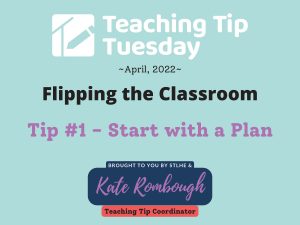
What is a flipped classroom?
The term “flipped classroom” refers to courses where the traditional components — lectures and homework — are reversed; that is, students interact with course content and concepts outside of class time (for example, via lectures delivered as podcasts or screencasts) leaving class time free for active learning, collaborative activities (such as discussions, debates, demonstrations, etc.). There is evidence that having students engage in active learning and peer learning in class leads to deeper understanding and greater retention of concepts than traditional lecture information transfer in class.
Why should I use the flipped classroom approach?
This approach can be used to improve the teaching and learning that occurs in a class. Specifically, flipped classrooms can… help keep students focused and learning for a whole period of learning. give students time to process and reflect on concepts and increase their knowledge base before coming to class to apply their learning. give instructors a sense of where students are having difficulty with the course material or have questions or misconceptions about concepts (possibly through an online assessment or discussion forum) before they come to class. allow instructors to adjust what will be done in class depending on student feedback. This is often called “just-in-time teaching” (JITT). put students in control of the time, pace and place of learning with the online materials. save time as the materials can be reused by the instructor from year to year. add some variety and change of pace to classes and make the course more interesting for both students and instructor.
How should I get started flipping my classroom? Start with a Plan.
As in all class planning, the objectives of the class must be determined before the activities are planned, and an up-front investment of time is necessary to create online materials, including video content. By using the following planning model you will ensure student motivation and engagement.
Flipped Class Planning Model
Motivation:
| Step #1 – Introduce the out-of class task
Set the stage Communicate clear expectations Time commitment Degree of challenge for the students Step #2 – Out-of-class task Consider media choice Resources Create guiding questions Means for students to ask questions Step #3 – Assess their learning Evidence of student preparation Self assessment Formative feedback Low stakes in-class assessment Step #4 – In-class/ synchronous activity Link activities to outcomes & assessments Peer-to-peer dialogue, collaboration, application Student-instructor dialogue JITT (Just-In-Time-Teaching) |
See you next week for a new tip!
Attribution Statement: This resource was adapted from
- Course Design: Planning a Flipped Class. (2013, July 30). Centre for Teaching Excellence, Waterloo University. https://uwaterloo.ca/centre-for-teaching-excellence/teaching-resources/teaching-tips/planning-courses-and-assignments/course-design/course-design-planning-flipped-class CC-BY-NC-SA 4.0
- Introduction to the Flipped Classroom. (2015, January 21). Centre for Teaching Excellence, Waterloo University.https://uwaterloo.ca/centre-for-teaching-excellence/workshop-resources/introduction-flipped-classroom CC-BY-NC-SA 4.0
